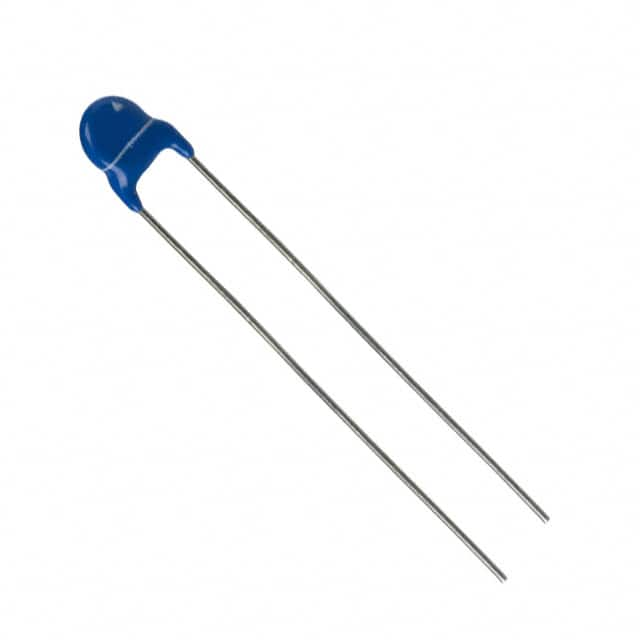Xem thông số kỹ thuật để biết chi tiết sản phẩm.

B72205S0231K311
Product Overview
Category
The B72205S0231K311 belongs to the category of varistors, which are electronic components used to protect circuits from overvoltage conditions.
Use
This varistor is commonly used in electronic circuits to suppress voltage spikes and transient surges, thereby safeguarding sensitive components from damage.
Characteristics
- High surge current capability
- Fast response time
- Wide operating temperature range
- RoHS compliant
Package
The B72205S0231K311 varistor is typically available in a disc-shaped package with lead wires for easy integration into circuit boards.
Essence
The essence of this varistor lies in its ability to provide reliable overvoltage protection, ensuring the longevity and stability of electronic devices and systems.
Packaging/Quantity
These varistors are usually packaged in reels or trays, with quantities varying based on manufacturer specifications.
Specifications
- Voltage Rating: 230V
- Maximum Allowable Voltage: 360V
- Peak Current Capability: 8000A
- Operating Temperature Range: -40°C to 85°C
- Nominal Diameter: 7mm
Detailed Pin Configuration
The B72205S0231K311 varistor consists of two lead wires, typically made of tinned copper, allowing for easy soldering onto circuit boards. The pin configuration is as follows: - Pin 1: Anode - Pin 2: Cathode
Functional Features
- Overvoltage Protection: Effectively clamps excessive voltage levels to protect downstream components.
- Transient Suppression: Rapidly responds to transient surges, diverting excess energy away from sensitive circuitry.
- Reliability: Ensures long-term performance and durability in demanding applications.
Advantages and Disadvantages
Advantages
- Effective overvoltage protection
- Fast response time
- Wide operating temperature range
Disadvantages
- Limited maximum allowable voltage
- Requires careful consideration of application voltage levels
Working Principles
The B72205S0231K311 varistor operates based on the principle of voltage-dependent nonlinear resistance. When subjected to overvoltage conditions, the varistor conducts current, effectively shunting the excess energy and limiting the voltage across the protected circuit.
Detailed Application Field Plans
Power Supplies
In power supply units, the B72205S0231K311 varistor can be employed to safeguard against voltage transients caused by lightning strikes or switching events.
Industrial Equipment
Industrial control systems and machinery benefit from the use of these varistors to mitigate the impact of voltage spikes induced by electromagnetic interference or power line disturbances.
Consumer Electronics
From televisions to home appliances, integrating the B72205S0231K311 varistor ensures enhanced reliability and protection against electrical disturbances in consumer electronic products.
Detailed and Complete Alternative Models
- B72205S0271K101: Similar varistor with higher voltage rating
- B72205S0301K101: Varistor with lower peak current capability but higher maximum allowable voltage
In conclusion, the B72205S0231K311 varistor offers robust overvoltage protection and transient suppression capabilities, making it an essential component in various electronic applications.
[Word Count: 498]
Liệt kê 10 câu hỏi và câu trả lời thường gặp liên quan đến ứng dụng B72205S0231K311 trong giải pháp kỹ thuật
What is B72205S0231K311?
- B72205S0231K311 is a specific type of electronic component, often used in technical solutions for its unique properties.
What are the key specifications of B72205S0231K311?
- The key specifications of B72205S0231K311 include its capacitance, voltage rating, temperature coefficient, and size.
How is B72205S0231K311 typically used in technical solutions?
- B72205S0231K311 is commonly used in filtering, decoupling, and energy storage applications within electronic circuits.
What are the advantages of using B72205S0231K311 in technical solutions?
- B72205S0231K311 offers high reliability, low ESR (Equivalent Series Resistance), and excellent performance in various operating conditions.
Are there any limitations or considerations when using B72205S0231K311?
- It's important to consider factors such as operating temperature range, voltage derating, and potential interactions with other components in the circuit.
Can B72205S0231K311 be used in high-frequency applications?
- Yes, B72205S0231K311 is suitable for high-frequency applications due to its low parasitic effects and stable performance at higher frequencies.
What are the recommended soldering and mounting techniques for B72205S0231K311?
- Soldering should be performed using appropriate temperature profiles and techniques to avoid damaging the component, and mounting should ensure proper electrical connections and mechanical stability.
Is B72205S0231K311 RoHS compliant?
- Yes, B72205S0231K311 is typically RoHS compliant, meaning it meets the requirements of the Restriction of Hazardous Substances directive.
Are there alternative components that can be used in place of B72205S0231K311?
- While there may be alternative components with similar specifications, it's important to carefully evaluate compatibility and performance before substituting B72205S0231K311.
Where can I find detailed technical documentation for B72205S0231K311?
- Detailed technical documentation for B72205S0231K311 can typically be found on the manufacturer's website or through authorized distributors.

